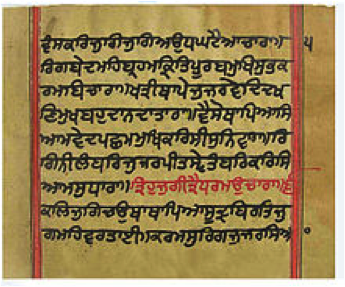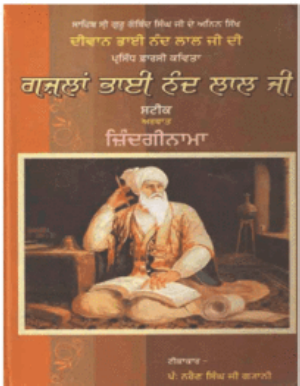"This article 'Three Pillars for a Fulfilled Life' written by Dr. Bhai Harbans Lal was originally published on June 19th 2017. It challenges the supposed three pillars of Guru Nanak's teaching of 'Naam Japo, Keerat Karo, Vand Chhako' and definitively demonstrates that the scriptural and historical three pillars are actually 'Naam, Daan, Ishnaan'. This is an important sea change not only for us to be more accurate in describing our philosophy but in understanding it! This absolute must read is part one of three and we are grateful to republish it in honor of SikhNet's 25th anniversary."
Many research studies on the purpose of life indicate that every living being is seeking fulfillment as their most cherished purpose. A recent survey concluded that, more and more, North Americans tend to live lives driven by their most precious goals. They continue to be physically active and otherwise engaged in achieving the goals they cherish.
This essential purpose of fulfillment is becoming the primary preoccupation of every conscientious person. Therefore, we must evaluate the characteristics of those objectives to understand if they will enable our communities to have purposeful lives.
To help the ordinary citizen in achieving this goal, Guru Nanak evolved three categories of core values to live by. These core values were the central theme during his wide-ranging missionary endeavors. Both he and his nine successors detailed in their teachings the kinds of actions that would constitute the three categories, and create a fulfilling human life.
In his teachings, Guru Nanak designated three core values that, when blended, would transform life into something wonderful. In doctrinal terms, Guru Nanak named them as NAAM, DAAN, ISHNAAN. Translated into today’s idiom, they are:
NAAM – Mindful Awareness of Divine Presence
DAAN – Live Out the Culture of Altruism when Seeking Divine Benevolence
ISHNAAN – Implement Ethics of Good Deeds that Cleanse Body and Mind
I hope to dedicate considerable time to write several essays exploring what these doctrines mean. They are detailed in Sikh scriptures. In this essay, I will only review the scriptural authority as well as historical evidence in support of whether NAAM- DAAN- ISHNAAN was indeed the terminology the Gurus selected to communicate their primary teachings. I will also review how these heavenly terms have been altered into newer vocabulary that the Gurus neither ordained nor spoke. However, this more recent vocabulary is being adopted subtly by our clergy, entirely out of ignorance.
ORIGIN AND GROUNDWORK
The principles of the Sikh Rehat, which are guidelines for daily practice, first originated in Guru Nanak’s teachings. The Guru spread the divine message to all those coming to him and thus laid the groundwork for a universal Code of Conduct (Rehat Maryada). This code was meant to be timeless and meant for everyone without any prejudice of race, religion, gender or nationality. It is a comprehensive guide to living pertinently for every member of humanity.
 As the tradition goes, the original code of values was summed up by the Guru himself in three theological terms, NAAM DAAN ISNAAN (ਨਾਮੁ, ਦਾਨੁ, ਇਸਨਾਨੁ). In every opportunity to transmit his ministry, the Guru emphasized a lifestyle based upon these precepts. For example, this was the first pronouncement of his ministry after his enlightening meditation along the banks of the rivulet vein nadi, at the age of 27.
As the tradition goes, the original code of values was summed up by the Guru himself in three theological terms, NAAM DAAN ISNAAN (ਨਾਮੁ, ਦਾਨੁ, ਇਸਨਾਨੁ). In every opportunity to transmit his ministry, the Guru emphasized a lifestyle based upon these precepts. For example, this was the first pronouncement of his ministry after his enlightening meditation along the banks of the rivulet vein nadi, at the age of 27.
The enlightening meditation around vein nadi is considered the most significant event in the life of the founder of the Sikh religion [1]. Historians describe this event as the occasion immediately after which Guru Nanak undertook his universal ministry. It is then that he spoke to the public and pronounced that he was inspired by the Creator with messages for all humanity.
Referring to this message, the writers of the oldest available Sikh history, ancient Meharban Vaalee Janam Sakhi, described the Divine instructions to the Guru as saying,
O’ Nanak, those you accept, will be given salvation in the court of the Divine, .. you are ordained to undertake the mission of both articulating and inculcating the practice of NAAM DAAN ISNAAN in the millennium of the coming ages [2]…
In recorded Sikh history, it is from this event and time that the NAAM DAAN ISNAAN terms were rightfully regarded as representing the core doctrines of Sikhism. The same doctrines were routinely preached in the Sikh congregations, and a lot has been written about their meanings and implications in life.
Following this event of vein nadi, the sacred terms, NAAM DAAN ISNAAN (ਨਾਮੁ, ਦਾਨੁ, ਇਸਨਾਨੁ) were made a part of the Gurmat philosophy, and Sikh values. Thereafter, the Gurus and other Sikh theologians as well as Sikh exegists actively popularized these terms and the teachings behind them. From this time onward, these terms and the concepts they represented would continue to be recognized as the fundamentals of Sikhism. They were variously translated and explained with the changing times according to the needs of the local languages and customs. This is not unusual. With the changing socio-political milieu, with the cultural as well as the etymological needs, it is expected that, with time, more contemporary terms would be employed to express the essence of the original diction and basic concepts contained in Nanak’s three canons.
From this time onward, these terms and the concepts they represented would continue to be recognized as the fundamentals of Sikhism. They were variously translated and explained with the changing times according to the needs of the local languages and customs. This is not unusual. With the changing socio-political milieu, with the cultural as well as the etymological needs, it is expected that, with time, more contemporary terms would be employed to express the essence of the original diction and basic concepts contained in Nanak’s three canons.
The evolution of terminology is expected with time; however, a great caution must be exercised to preserve the original terms and their meanings as they embody the canons and the doctrines. When newer terms are introduced, they may subtly begin to taint the original significance of the canons to accommodate the expression of many cultural and geographical needs. Once accepted, the subtle changes have a tendency to introduce distortions of the original meaning.
To guard against any long-lasting variation in the essence of the terms, it must be emphasized periodically that the basic principles must be referred to by the original doctrinal terms coined by the founders themselves; or by those subsequently authenticated by the Gurus themselves; or done so by their contemporary theologians.
 SCRIPTURAL SANCTITY OF NAAM DAAN ISHAAN
SCRIPTURAL SANCTITY OF NAAM DAAN ISHAAN
Sikhs consider the verses contained in the volume of Sri Guru Granth Sahib (SGGS) as the Eternal Guru whose wisdom mus not be contested. It is these verses that provide indisputable support for the terms that Guru Nanak had chosen. They are then promoted by the Guru’s contemporary theologians and exegetists. Let us examine those documents.
THE GURU’S OWN SERMONS
Above all the other supporting evidence, the Gurus themselves emphasized the rehat of NAAM DAAN ISNAAN. For instance, the Guru wrote down the terms in their own verses as,
ਸੁਣਿ ਗਲਾ ਗੁਰ ਪਹਿ ਆਇਆ ॥ ਨਾਮੁ ਦਾਨੁ ਇਸਨਾਨੁ ਦਿੜਾਇਆ ॥
ਸਭੁ ਮੁਕਤੁ ਹੋਆ ਸੈਸਾਰੜਾ ਨਾਨਕ ਸਚੀ ਬੇੜੀ ਚਾੜਿ ਜੀਉ,, SGGS, p. 74
I heard of the Guru’s repute, and so I went to the Guru. The Guru instilled within me the teaching of Naam, Daan, Isnaan. Said Nanak, this was the path through which whole humanity may be liberated as the way of Naam, Daan, Isnaan puts the seeker on the boat of eternal truths.
ਗੁਰਮੁਖਿ ਨਾਮੁ ਦਾਨੁ ਇਸਨਾਨੁ SGGS, p, 942
The Guru-Oriented seekers receive the wisdom of
”NAAM, DAAN, ISNAAN" (ਨਾਮੁ, ਦਾਨੁ, ਇਸਨਾਨੁ) to attune to the blissful state.
ਨਾਮੁ ਦਾਨੁ ਇਸਨਾਨੁ ਦ੍ਰਿੜੁ ਹਰਿ ਭਗਤਿ ਸੁ ਜਾਗੇ, SGGS, p. 419
The devout is awakened to the Worship of the Divine with firm faith
in the lifestyle of ”NAAM DAAN ISNAAN”
ਦ੍ਰਿੜੁ ਨਾਮ ਦਾਨੁ ਇਸਨਾਨੁ ਸੁਚਾਰੀ, SGGS, p. 740
Instill in your life, NAAM DAAN AND ISNAAN
as the acts of piousness.
When the Guru found an occasion to deliver his sermon, he used those opportunities to stress his mission. He emphasized the principles of his new religion irrespective of the faith of the audience. For example, on two premier holy festivals of Hindus, both Guru Nanak and Guru Arjan preached as follows.
ਦਸਮੀ ਨਾਮੁ ਦਾਨੁ ਇਸਨਾਨੁ, SGGS, p. 840
On the day of Dasami observance, dedicate yourself to the
life of NAAM DAAN AND ISNAAN.
ਦੁਆਦਸੀ ਦਾਨੁ ਨਾਮੁ ਇਸਨਾਨੁ, SGGS, p. 299
On the day of Duadsi observance, commit yourself to the practice of NAAM DAAN AND ISNAAN.
The Guru instructed the Sikh theologians to use NAAM DAAN ISNAAN as subjects for their exegeses.
ਨਾਮੁ ਦਾਨੁ ਇਸਨਾਨੁ ਦਿੜੁ ਸਦਾ ਕਰਹੁ ਗੁਰ ਕਥਾ, SGGS, p. 1101
Confirm your faith in the NAAM DAAN ISNAAN, and always
use these topics for exegeses.
As far as we know, like other Gurus, Guru Gobind Singh continued the tradition of using the terms: “NAAM, DAAN, ISNAAN.” There are several references to them in the Guru’s teachings.
It is thus clear that the terms employed to describe the three pillars of the Sikh way of life were never allowed to any alteration in over two centuries of the Gurus’ lives. It is not wise, therefore, to permit any change now. This certainly does not preclude any restriction, however, on translating them into contemporary idioms when necessary, as long as the original terms are not forgotten.
TESTIMONY OF BHAI GURDAS
Bhai Gurdas (1551 – 1636) was Guru Arjun’s scribe who co-complied the first recension of the Guru Granth. Bhai Gurdas was the son of Datar Chand Bhalla, a first cousin of Guru Amar Das; his cousin’s sister, Bibi Bhani, was married to Guru Ram Das and was the mother of Guru Arjan. This made Bhai Gurdas the maternal uncle of Guru Arjan. Thus, Bhai Gurdas may be considered the Sikh best connected to the Gurus’ family and the Guru’s teachings. Also, he had a singular privilege of living through the time up to the sixth Guru and is considered the first missionary of Sikh philosophy and mysticism.
 Bhai Gurdas wrote extensively on the Gurmat philosophy and the Sikh way of life. Guru Arjan designated Bhai Gurdas’s writings as the key to the Guru Granth Sahib. In this capacity, Bhai Gurdas was the first to outline Guru’s own instructions on the theology and morality of the Sikh community in the Gurus’ time and for the times to come.
Bhai Gurdas wrote extensively on the Gurmat philosophy and the Sikh way of life. Guru Arjan designated Bhai Gurdas’s writings as the key to the Guru Granth Sahib. In this capacity, Bhai Gurdas was the first to outline Guru’s own instructions on the theology and morality of the Sikh community in the Gurus’ time and for the times to come.
Bhai Gurdas elected to include his testimony on the injunctions of NAAM DAAN ISNAAN (ਨਾਮੁ, ਦਾਨੁ, ਇਸਨਾਨੁ) in his very first Pauri or verse. This pauri was composed as an homage to the founder of the religion, Guru Nanak, and as an overview of his composition. It goes as follows:
ਭਾਉ ਭਗਤਿ ਗੁਰਪੁਰਬ ਕਰਿ ਨਾਮ ਦਾਨ ਇਸਨਾਨ ਦ੍ਰਿੜ੍ਹਾਯਾ [3]
I bow to Guru Nanak who transformed his followers world into those who continually rededicate themselves to the Guru’s principles through the celebration of the Guru’s greatness and emphasize on others the Guru’s path of NAAM DAAN ISNAAN.
Similarly, when Bhai Gurdas narrated the foundation of the Panth, he included the injunctions of NAAM DAAN ISNAAN as its essential component.
ਗੁਰਮੁਖ ਪੰਥੁ ਚਲਾੳਿਨੁ ਨਾਮੁ ਦਾਨੁ ਇਸਨਾਨੁ ਦ੍ਰਿੜਾਯਾ [4]
The Guru founded the path of Guru oriented by
emphasizing NAAM DAAN ISNAAN
Further, when Bhai Gurdas described the teachings that Guru asked his followers to abide by, it contained NAAM DAAN ISNAAN as a critical component.
ਪਰ ਤਨ ਪਰ ਧਨ ਪਰ ਨਿੰਦ ਮੇਟਿ ਨਾਮੁ ਦਾਨੁ ਇਸਨਾਨੁ ਦ੍ਰਿੜਾਯਾ [5]
Among the virtues that the Guru had emphasized included;
to be truthful, content, merciful, religious
and the practitioner of NAAM, DAAN, AND ISNAAN.
ਸਤਿ ਸੰਤੋਖ ਦਯਾ ਧਰਮ ਨਾਮ ਦਾਨ ਇਸਨਾਨ ਦ੍ਰਿੜਾਯਾ
For inculcating the Truth, fulfillment, mercy and divinity,
the Guru emphasized NAAM DAAN ISNAAN
Bhai Gurdas considered the practice of NAAM DAAN ISNAAN as a fulfillment of the Guru’s teachings. He wrote,
ਗੁਰ ਉਪਦੇਸ਼ ਕਮਾਵਣਾ ਗੁਰਮੁਖਿ ਨਾਮ ਦਾਨ ਇਸਨਾਨਾ [6]
To a Guru oriented individual, the practice of NAAM DAAN ISNAAN constitutes the fulfillment of Guru’s teachings.
TESTIMONY OF BHAI NAND LAL
Bhai Nand Lal was the Poet Laureate of Guru’s court and the most dearly loved disciple of Guru Gobind Singh. He wrote two rehatnamas; one known as Rehatnama written in 1695, i.e., four years before the presently most celebrated Vaisakhi of 1699, and the other in 1699 known as Tankhahnama.
 Guru Gobind Singh himself asked Nand Lal to compile Guru’s injunctions for the guidance of the Sikh communities after the Guru left his human body for his heavenly abode. Both Rehatnama and Tankhahnama were believed to be written under the personal guidance of Guru Gobind Singh. These pieces were composed in the style of a conversation between the Guru and Bhai Nand Lal.
Guru Gobind Singh himself asked Nand Lal to compile Guru’s injunctions for the guidance of the Sikh communities after the Guru left his human body for his heavenly abode. Both Rehatnama and Tankhahnama were believed to be written under the personal guidance of Guru Gobind Singh. These pieces were composed in the style of a conversation between the Guru and Bhai Nand Lal.
In these compositions, Guru Gobind Singh asked Bhai Nand Lal to convey to the Sikhs the following message for inclusion in their daily code of conduct.
ਸੁਨਹੁ ਭਾਈ ਨੰਦ ਲਾਲ ਜੀ ਸਿਖ ਕਰਮ ਹੈ ਏਹੁ ।।
ਨਾਮ ਦਾਨੁ ਇਸਨਾਨੁ ਬਿਨੁ ਕਰੇ ਨ ਅੰਨ ਸਿਉ ਨੇਹੁ [7]
Listen, O, my dear Bhai Nand Lal, the religious deeds of the Sikhs are defined as follows – but for NAAM, DAAN, ISNAAN, a Sikh should not form an association with anything else.
After perusing the testimonies above, there should be no question or doubt that NAAM, DAAN, ISNAAN were the major doctrines and the doctrinal terms that form all of the Sikh teachings.
REPLACEMENT OF ORIGINAL TERMS: ORIGIN AND IMPLICATIONS
A cursory view of current trends in Sikh publications, youth programs, and other ceremonies reveals that the essence of certain textual canons of Sikh principles may be gradually altering without any one’s notice. The Guru’s principles of NAAM DAAN ISNAAN (ਨਾਮੁ, ਦਾਨੁ, ਇਸਨਾਨੁ)[8] are being substituted by virtually non-Gurbani terms to suit the convenience and circumstances. Whereas the motives of the writers and speakers may be genuine, there is a risk of tainting the fundamental canons of Sikhism with the passage of time.
Other terms which are becoming more popular in the Punjabi regions of the Indian sub-continent to describe the Guru’s three precepts are Naam Japo, Vand Chhako, Kirat Karo, instead of NAAM, DAAN, ISHNAAN. These are newer terms that Guru never spoke or wrote; they were coined during the post-Guru periods and only recently. The time of their exact origin is not known, but I have a hunch. They certainly came to exist only after the partition of the Indian subcontinent in 1947.
Very different terms erroneously considered equivalent to represent the same ideas were mentioned by Bhai Mani Singh. But he used each of them separately, never troika of three words. It is a common belief that Bhai Vir Singh allowed the use of these terms naam japo, vand chhako, dharam di kirat karo only to blunt Communist influence on the Sikh Youth, and never to replace the original doctrines. The motivation was to stress that Sikhism had already imbibed two major slogans of the Communist movement. And Sikhism goes beyond that, by emphasizing a belief in God to which Communism was opposed.
I distinctly recall this point being highlighted in the Sikh youth gatherings by the All India Sikh Students Federation, and other Sikh activist movements, myself being included and enthusiastically part of it. The idea was noble. It was to not permit heavily propagated communism to impact our youth. All the youth leaders supported the idea and heavily emphasized these points in our presentations.
Although the intention at that time was laudable, and it served its purpose well, the vast popularity of these new terms gradually began to erode the originals NAAM DAAN ISNAAN doctrines. The newer terms, naam japo, vand chhako, dharam di kirat karo that were only meant to halt communist inroads, over time began to corrupt the original intention. Some authors even unwittingly started to go astray in their exposition while explaining the terms in the context of their own understanding. They would preach these words of naam japo, vand chhako, dharam di kirat karo as if they the original injunctions of the Gurus. But certainly that is not true. None of the ten gurus ever spoken those terms as a troika. However, the temporarily employed terms became to enter encyclopedias and other literature. That need to be halted and discouraged whenever there is opportunity to do so.
CONCLUSION
It was Guru Nanak who gave us the divinely inspired guidelines towards a most fulfilled life. All his successors and the exegetes of the time actively promoted the same, so we may live our life in the most fulfilled way. We continued to follow the Guru for centuries afterward.
A cursory view of the present trend in Sikh publications, youth programs, and other ceremonies reveals that the essence of certain textual canons of Sikh principles may be gradually losing the original intention of the Guru without any one’s notice. The Guru’s principles of NAAM DAAN ISNAAN (ਨਾਮੁ, ਦਾਨੁ, ਇਸਨਾਨੁ)[9] are being substituted by virtually non-Gurbani phrases to suit the convenience and circumstances. Whereas the motives of those who are popularizing the much-altered terms may be genuine, there is a risk of tainting the Gurmat doctrines this way with the passage of time.
To halt this erosion of the real intention of the Guru, it is prudent to favor references to the doctrinally precise words chosen by the Gurus themselves. It is for this reason that this author decided to cite the original testimonies of the Scriptures in support of the correct representation of these terms. They were for sure, NAAM DAAN ISNAAN (ਨਾਮੁ, ਦਾਨੁ, ਇਸਨਾਨੁ) and none else. It is certainly time for the leadership of our institutions to actively stop the erosion of Gurus’ given original terms by preserving and actively propagating their usage again.
Future essays will delve into our current understanding of the Guru’s teachings as defined in his spiritually inspired doctrines of NAAM DAAN ISNAAN (ਨਾਮੁ, ਦਾਨੁ, ਇਸਨਾਨੁ). It will also be deliberated that the doctrines embedded in these terms are meant for universal application in today’s civil societies.
REFERENCES
[1] Singh, O.: Jot Prakash Dus Guru Saheban, Vismaad Naad, 1 (1), 193, 1994.
[2] as cited by Onkar Singh, In: Jot Prakash Dus Guru Saheban, Vismaad Naad, 1 (1), 196, 1994.
- Updated from earlier version: Hal, H., Scriptural Sanctity of Naam Daan Isnaan, Sikh Review, 44 (November): 7-11, 1996.
- The verses from the Sri Guru Granth Sahib (SGGS) are cited in original Gurmukhi script with the page numbers according to the Granth published by Shiromni Parbhandak Committee, Amritsar. Each verse is followed by a brief English commentary in the light of the subject of this discussion and may be distinct from an exact translation.
[3]Gurdas, Bhai, In Varan Bhai Gurdas, Var 1, Pauri 1, Sixth Edition reprinted Bhai Vir Singh Sahit Sadan, New Delhi, 1992.
[4]Gurdas, Bhai, In Varan Bhai Gurdas, Var 23, Pauri 1, Sixth Edition reprinted by Bhai Vir Singh Sahit Sadan, New Delhi, 1992
[5]Gurdas, Bhai, In Varan Bhai Gurdas, Var 29, Pauri 2, Sixth Edition reprinted Bhai Vir Singh Sahit Sadan, New Delhi, 1992
[6]Gurdas, Bhai, In Varan Bhai Gurdas, Var 30, Pauri 15, Sixth Edition reprinted Bhai Vir Singh Sahit Sadan, New Delhi, 1992
[7] Rehhatnama Bhai Nand Lal, 1. 17. (Also, it appears in Tankhahnama by Bhai Nand Lal).
[8] For detailed discussion on the meanings of these terms see, Harbans Lal, The Three Pillars of Spiritual Living, From Both sides of the Ocean, January-February Issue, 16-19, 1996.
[9] For detailed discussion on the meanings of these terms see, Harbans Lal, The Three Pillars of Spiritual Living, From Both sides of the Ocean, January-February Issue, 16-19, 1996.-------------------------------------
Read Part 2 - "Naam - Password for Universal Reality" here
Read Part 3 - "Three Pillars for a Fulfilled Life: Daan – Altruism" here





